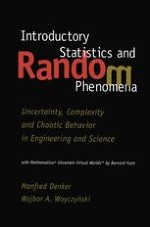1998 | Buch
Introductory Statistics and Random Phenomena
Uncertainty, Complexity and Chaotic Behavior in Engineering and Science
verfasst von: Manfred Denker, Wojbor A. Woyczyński, Bernard Ycart
Verlag: Birkhäuser Boston
Buchreihe : Statistics for Industry and Technology
Enthalten in: Professional Book Archive
